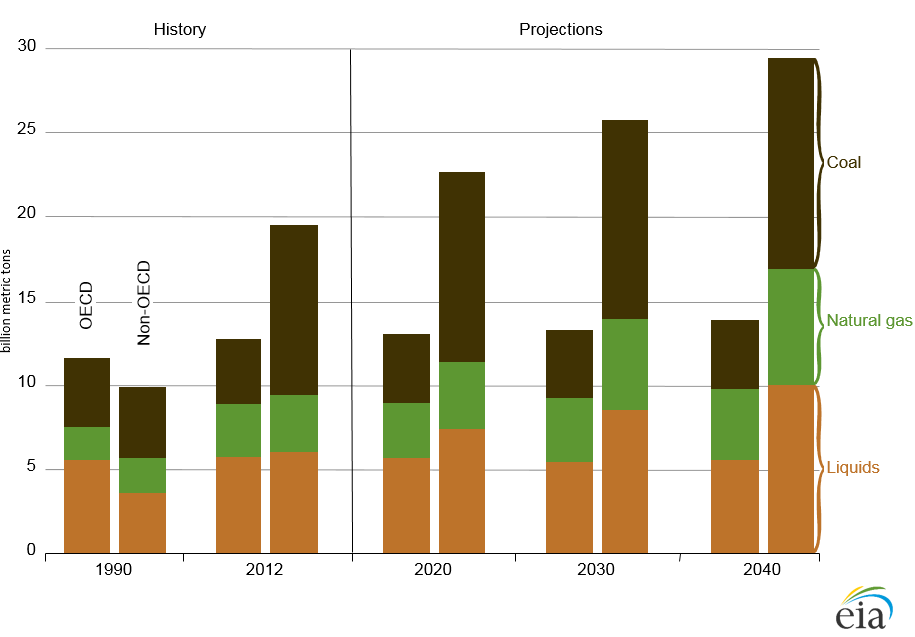According to the U.S. EPA, fossil fuels are the leading source of global carbon dioxide emissions, and according to data available from the International Energy Agency (IEA), coal is responsible for just over 44% of all energy-related emissions worldwide. Coal is the most carbon-intensive fossil fuel, which means it emits more CO2 than an equivalent amount of oil, natural gas, or other fossilized hydrocarbon. According to the EIA's 2019 International Energy Outlook (IEO2019), coal became the leading source of world energy-related carbon dioxide emissions in 2006. Projections through 2050 indicate that it remains the leading source, even though the IEO2019 projects that natural gas emissions will rise the most year-on-year (1.1% per year increase for natural gas vs. 0.4% per year for coal). According to the IEO2016, all of this coal-based emissions growth in the reference scenario is in non-OECD countries, as you can see in the chart below.

Click link to expand for a text description of Figure 6.2
| Year | Country Type | Coal | Natural Gas | Liquids |
|---|---|---|---|---|
| 1990 | OECD | 4.10 | 1.97 | 5.52 |
| 1990 | Non-OECD | 4.25 | 2.01 | 3.60 |
| 2012 | OECD | 3.93 | 3.13 | 5.72 |
| 2012 | Non-OECD | 10.07 | 3.44 | 5.97 |
| Year | Country Type | Coal | Natural Gas | Liquids |
|---|---|---|---|---|
| 2020 | OECD | 4.10 | 3.32 | 5.60 |
| 2020 | Non-OECD | 11.28 | 3.99 | 7.34 |
| 2030 | OECD | 4.06 | 3.77 | 5.49 |
| 2030 | Non-OECD | 11.87 | 5.38 | 8.52 |
| 2040 | OECD | 4.01 | 4.24 | 5.56 |
| 2040 | Non-OECD | 12.47 | 6.94 | 9.99 |
As described previously, burning coal also releases other dangerous pollutants, including soot and fly ash, sulfur, nitrogen oxides, and mercury. There is no known technology that can eliminate all of these pollutants. Even if they could, there are environmental consequences of coal extraction and processing. That is why the term "clean coal" is controversial, and frankly speaking a misnomer - there is no such thing as "clean" coal, only coal plants whose CO2 emissions are reduced or eliminated. But that aside, coal resources are abundant, coal-fired power plants are extremely reliable, and coal is relatively cheap (ignoring externalities of course), though in the past 10 years or so natural gas has been replacing coal as the power generation fuel of choice because it is less expensive.
Worldwide, efforts and projects are underway to mitigate the environmental impact of carbon combustion. Some of the technologies involved include scrubbers, selective catalytic reduction, fluidizer bed boilers, gasification, and carbon capture and sequestration (CSS).

Technology to Mitigate Environmental Impacts of Coal
The National Mining Association has published a helpful Clean Coal Technology Backgrounder. The following is an excerpt, which describes currently available technologies.
Power plants being built today emit 90 percent less pollutants (SO2, NOx, particulates, and mercury) than the plants they replace from the 1970s, according the National Energy Technology Laboratory (NETL). Regulated emissions from coal-based electricity generation have decreased overall by over 40 percent since the 1970s, while coal use has tripled, according to government statistics. Examples of technologies that are deployed today and continue to be improved upon include:
Fluidized-bed combustion–Limestone and dolomite are added during the combustion process to mitigate sulfur dioxide formation. There are 170 of these units deployed in the U.S. and 400 throughout the world.
Integrated Gasification Combined Cycle (IGCC)–Heat and pressure are used to convert coal into a gas or liquid that can be further refined and used cleanly. The heat energy from the gas turbine also powers a steam turbine. IGCC has the potential to improve coal’s fuel efficiency rate to 50 percent. Two IGCC electricity generation plants are in operation in the U.S.
Flue Gas Desulfurization– Also called “scrubbers,” and removes large quantities of sulfur, other impurities, and particulate matter from emissions to prevent their release into the atmosphere.
Low Nitrogen Oxide (NOx) Burners– Reduce the creation of NOx, a cause of ground-level ozone, by restricting oxygen and manipulating the combustion process. Low NOx burners are now on 75 percent of existing coal power plants.
Selective Catalytic Reduction (SCR)– Achieves NOx reductions of 80-90 percent or more and is deployed on approximately 30 percent of U.S. coal plants.
Electrostatic Precipitators – Remove particulates from emissions by electrically charging particles and then capturing them on collection plates.
Optional Reading
If you're interested in more detail, try visiting the DOE's Clean Coal News site.
To Read Now
For a summary of the various clean coal technologies, as well as some of the pros and cons, please read the following:
- "Carbon Capture," Center for Climate and Energy Solutions
- "Everything You Need to Know About Clean Coal", Popular Mechanics, November 2020
